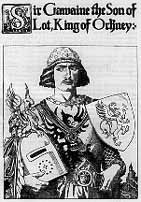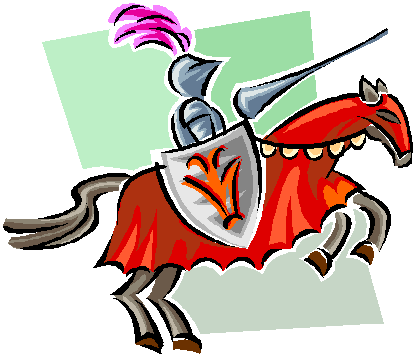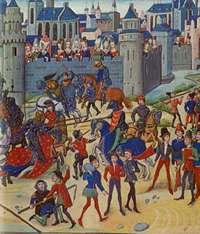|
Rebecca Caudill Young Readers Book Award Nominees 2003 |
Connections |
|||||||
Terence is an orphan raised by a holy man in the woods near Camelot. He does not know who his mother or his father were. On the day the story opens a strange green man plays tricks on Terence turning wood to weapons and quiet trees to dancing fools. Terence is so struck by this that he follows these strange happenings. It is not long before he meets Gawain, a good and kind knight, the nephew of King Arthur, on his way to Camelot to become, he hopes, a knight of the Round Table. Gawain selects Terence as his squire and the adventures begin. The
characters and stories in this book are based upon the stories of Gawain
in the legends and tales of Arthur and the Knights of the Round
Table. Only Terence and his lineage are the author's fiction, but
his retellings are true to the old tales (mostly). . . spritely, funny and,
above all, entertaining.
WORDS FOR THE WISE
Other Books About Camelot The Savage Damsel and the Dwarf by Gerald Morris. Her castle under siege by an evil knight who keeps beheading all her would be rescuers, Lady Lynet realizes the only way to get help is to go after it herself. So one night, she sets out for Camelot to find a gallant knight to vanquish her foe and free her castle. Knights of the Kitchen Table by Jon Scieszka Narrator Joe is given a magic book (''The Book'') that transports him and two friends to King Arthur's Britain, where they find themselves confronted by a fearsome Black Knight--who's easy to defeat with some quick dodging when he's in mid-charge. Then Lancelot, Gawain, et al. happen by and take the boys for heroes--a reputation they sustain by tricking the loathsome giant who's menacing the castle into fighting the terrible dragon (Smaug) that has also just turned up. Silly but satisfying. The Sword in the Tree by Clyde Bulla. It was then that Shan, the son of Lord Weldon, took on the duties of a knight and hid the sword in the hollow of the giant oak. The days that followed were filled with adventures that tried the courage of the young boy. Over Sea, Under Stone by Susan Cooper. The Drew children Simon, Jane, and Barney find an old map in a hidden room while summering at the Grey House in Cornwall. Along with their Great-Uncle Merry, they become embroiled in a web of intrigue that surrounds an Arthurian legend. A Connecticut Yankee in King Arthur's Court by Mark Twain. Twain tells the hilarious adventures of the Connecticut Yankee, a nineteenth-century mechanic who suffers a blow to the head and wakes up in King Arthur's Britain. The Yankee soon realizes this is not the gallant world of fairy tales, but a cruel, feudalistic society. Ever resourceful, he sets out to modernize and improve things through an ingenious and funny mix of magic and technology, chivalry and sheer tomfoolery. The Once
and Future King by T. H. White This
is the fantasy masterpiece by which all others are judged. |
GAWAIN Gawain is generally
said to be the nephew of Arthur. His parents are Lot of Orkney and Morgause
(though his mother is said to be Anna in Geoffrey
of Monmouth). Upon the death of Lot, he becomes the head of the Orkney
clan, which includes in many sources his brothers Aggravain, Gaheris, and
Gareth, and his half-brother Mordred.
Gawain figures prominently in many romances. In France he is generally
presented as one who has adventures paralleling in diptych fashion but not
overshadowing the hero's, whether that hero be Lancelot
or Perceval.
In the English tradition, however, it is much more common for Gawain to be
the principal hero and the exemplar of courtesy and chivalry, as he is in Sir
Gawain and the Green Knight and the other Arthurian romances of the
Alliterative Revival. In Malory's Morte d'Arthur, however, he has a
role similar to that in the French romances, in that Lancelot is the
principal hero. More about Sir Gawain King Arthur and His Knights of the Round Table by Roger Lancelyn Green. King Arthur Scholars and enthusiasts have been searching for evidence of King Arthur's existence and for Camelot since the stories were put to vellum (old type of paper). To date, there is no credible evidence of either, but many sites in Britain lay claim to Camelot. One of the most recent searches was a trip by two college students from the US to all the sites in Britain that claim Camelot. Read and see pictures of their trip. In Search of Britain's Lost King Camelot Project at the University of Rochester Coming to Camelot
Student Reviews Would you like to review this book? Click here.
This book all but begs to be read aloud. It's a bit violent, minor characters die left and right at the hand of Sir Gawain and other knights, but these are the authentic stories, simplified for a younger audience. If the class becomes hooked on the medieval, books at the left will lead to more treasures. Activity: So many activities have been centered around King Arthur and his court, it seems redundant to repeat them. However, the following sites offer ideas for teachers regarding this gallant, if violent age. KING
ARTHUR'S ROUND TABLE ROLL CALL Seventh Grade Study of Medieval Europe The Middle Ages was not all about feudalism and legend. Other cultures in other places were doing different things. This unit compares aspects of a number of cultures during the Middle Ages. |





 FOR
THE
TEACHER
FOR
THE
TEACHER